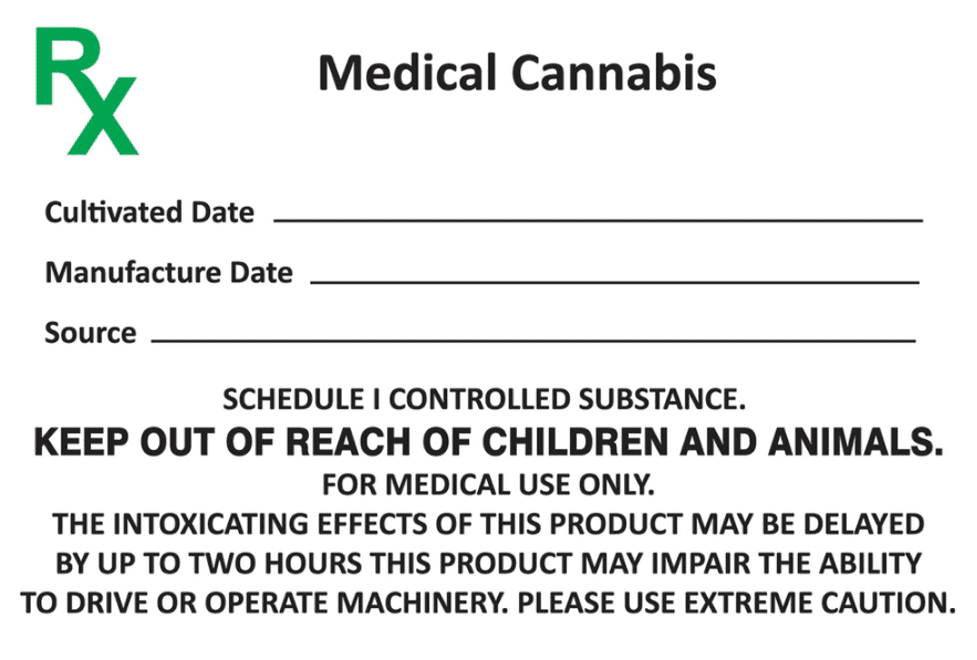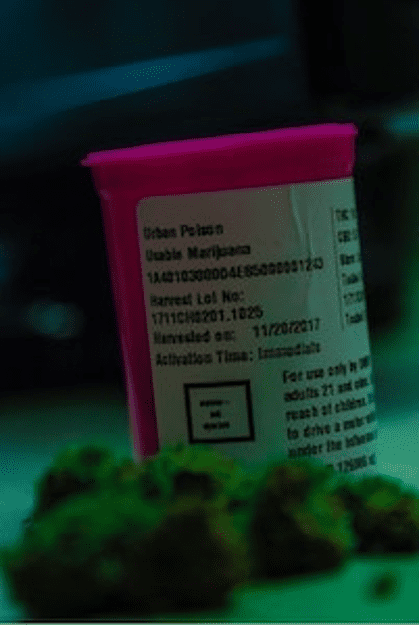
How to Read Medical Marijuana Labels
Every medical marijuana product is packaged with a descriptive label that highlights important information for patients. The packaging requirements are different in each state, but there are a few common details that you’re likely to find on most medical marijuana labels.
Details Commonly Found on Medical Marijuana Labels
Regardless of whether you’re purchasing a dry flower, gummy, or vape oil, note the following details.
A Product Identifier
This is typically one of the most prominent details at the top of the label. It might say “pre-roll,” “flower,” or “marijuana edible,” for example. Flower refers to the loose cannabis flower. A pre-roll is simply a pre-rolled marijuana cigarette.
A Cannabis Identifier
In almost every instance, the label will boldly note that the product contains marijuana. It might simply say “This is a marijuana product” at the top of the label, or it might contain a universal symbol like the kind used in California (pictured). Edible labels will sometimes contain the words “cannabis-infused.”

The Name of the Manufacturer
The manufacturer will usually have to identify themselves either by including their business name (or DBA), or their licensee number. Depending on the state where the product is packaged, address and contact information may also be included.
An Rx Symbol
Many medical marijuana products contain a green Rx symbol to signify that the product is intended for medicinal use.
Net weight
The medical marijuana product’s net weight is often indicated in both metric and U.S. customary units. The net weight is often used to determine product limits. For instance, Missouri limits patients to 112 grams of cannabis flower (or the equivalent) per month. Note that the net weight is not an indication of dosage or THC content.
A Lot/Batch Number
This number is used to identify the origin of the product, or from which batch it was derived. Legally grown cannabis is organized into numbered batches that are tracked via each state’s track-and-trace system. This ensures that the cannabis was legally cultivated and processed and is not a product of the black market.

A Government Warning
Some states, like California and New York, require explicit language to prevent unauthorized or unsafe use. In New York, for example, every label must contain the words “Keep out of reach of children” and “For use only by adults 21 years of age and older.” In Maryland, medical marijuana labels must indicate that “The contents may be lawfully consumed only by a qualifying patient named on an attached label.”
The Strain
This refers to the strain of cannabis from which the product was derived. In some cases, the label might identify a specific strain, like “Northern Lights” or “Blueberry Kush.” In other cases, it might just identify the subspecies, be it indica or sativa.
Indica’s are known for eliciting a body high, and they tend to be relaxing; sativa is known for promoting a head high and tend to be invigorating. If the label reads “70% sativa” or “55% indica,” you’re getting a hybrid strain. “55% indica” usually means that the product is 55% indica and 45% sativa.
The Date of Harvest
This is the final date when the cannabis was harvested. The packaging should include the month, date, and year. By knowing the date of medical marijuana harvest, you can ensure that the marijuana is relatively fresh. You ideally want the date of harvest to be recent, within the last 30 days. If your label doesn’t contain a date of harvest, it might alternately have a “Produced On” date.
The Date of Packaging
After the harvest, the cannabis is packaged and sealed for freshness. The packaging date should be within a few days of the harvest date. The packaging date is used in many states to determine the expiration or use-by date.
The Expiration Date
Marijuana doesn’t expire in the traditional sense; it just loses potency over time. Still, most medical marijuana labels will include an “Expiration” or “Best if Used By” date. Different states have different standards for deciding the use-by date, but many states use 60 days from the packaging date as a general standard. That doesn’t mean it’s unsafe to consume the product after that time.
The Testing Date
Some states require all medical marijuana to be tested by a third-party laboratory. Lab technicians look for pesticides, mold, and other impurities while also ensuring that the cannabis adheres to state law (e.g., THC limits). The lab will also provide specific cannabinoid and terpene profiles for labeling purposes.
Allergens
Allergens can often be found on medical marijuana edible labels. If an edible product contains known allergens like peanuts, tree nuts, wheat, or soy, this will typically be highlighted clearly as a disclaimer for buyers.
Moisture Content
In some cases, a cannabis product may highlight the moisture content. This is an important figure because dry cannabis is difficult and unpleasant to consume (and often less potent), while excessively moist cannabis can become a breeding ground for mold. A good moisture content for cured cannabis is between 8 and 10%.
Cannabinoid Content
The cannabinoids are the active compounds like THC, CBD, and CBN. Your label may identify the cannabinoids in a number of ways.
- Most medical marijuana labels will contain the total THC content. Remember that THC is the compound that gets you high. 10% THC is considered a moderate amount; 15% is high; 20% and above is considered extremely high.
- Some labels will break down the other cannabinoids individually. For instance, a label might read 12% THC, 2.4% CBD, .1% CBG, etc.…
- Some labels will list the total cannabinoid content. So, if the product is 12% THC, 2% CBD, and 1% other cannabinoids, the total cannabinoid content will be around 15%.
- Some labels will list “total cannabinoids” and “total active cannabinoids” as separate measurements. For instance, your label might read “16.3% total cannabinoids; 2.7% total active cannabinoids.” The active cannabinoids are those that have been activated through decarboxylation (heat). By heating the cannabis, you can convert cannabinoids from their acid form into their active form and increase the total active cannabinoids.
- Some labels will list the total THC per serving. So, if a cannabis cookie contains 20 mg of THC but is divided into four servings, it might read “5 mg of THC per serving.”
Terpene Content
Terpenes are the plant oils that give cannabis its familiar aromas. Terpenes also have therapeutic effects of their own. Different strains of cannabis have different terpene profiles, which is why no two strains smell exactly alike. In some cases, the label will list the individual terpenes along with their concentrations. Common cannabis terpenes include myrcene, limonene, pinene, and terpinolene.
The Activation Time
Not all marijuana products take effect at the same time. Dried cannabis flower activates within a few minutes. Vape oils activate almost instantly. Edibles can take up to an hour or more. By observing the activation time on the label, you can have a better idea of what to expect.
Nutritional Content
Most states require edibles to include nutrition labeling. California, for example, dictates that all edibles manufacturers disclose the product’s sodium, sugar, carbohydrates, and total fat per serving. The product ingredients may also be included.
Instructions for Use
Sometimes, the instructions might be simple: “Keep refrigerated” or “refrigerate after opening.” Other times, the label might have more detailed instructions for use, particularly if you’re purchasing vape oils, extracts, or other products that have a learning curve.
How to Read Medical Marijuana Labels
Once you understand what the label actually means, the question remains: How do you actually read the darned thing?
- First, look at the harvest, packaging, and expiration dates. Ensure that the product is fresh.
- Look for some indication that the product has been tested by a third-party lab. If the label doesn’t contain a test date, visit the manufacturer’s website to determine if the product has a certificate of analysis.
- Look for any allergens or other warnings that may be applicable to you.
- If you’re trying to decide how much to consume, note the cannabinoid content. At this point, you should know your ideal dosage (if not, speak to your recommending physician). If you’re dosing 10 mg of THC, and your product contains a total of 50 mg of THC, you’ll want to consume one-fifth of the product at a time.
If you have any questions about how to read medical marijuana labels, or if you’d like to inquire about how to get a medical marijuana card online, contact Green Health Docs.
